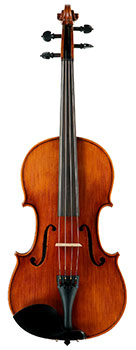Viola
The viola is the primary member of the viola family. It has four strings tuned in perfect fifths, and is played rested on the shoulder while using a bow. Music for the viola is written using the treble clef. The viola was first developed by instrument makers in Northern Italy who drew upon earlier Middle Eastern bowed instruments as inspiration. The viola is a versatile melodious instrument, which is also easy to transport due to its small size. As such, the viola is used in many genres of music including classical, country and bluegrass, Hungarian and gypsy, Celtic, pop and jazz.
The viola is not very different to the violin, essentially having only one string that is different. Where the violin is tuned GDAE and has a higher range, the viola is tuned CGDA and has a slightly lower range. The range of the violin is seen as being more compatible to bright, brilliant melodies, whereas its sister the viola, tends to play a counter melody - often a third or a fifth underneath the violins melody.
However, there are some notable differences in playing technique. As the viola is bigger than the violin, the finger positions are spread further apart, requiring the viola player to have greater technical skill than the violin player when playing the same passage. The viola is often heavier than the violin, and the bow is harder to handle as it is also weightier than the violin bow. The C string is much thicker than any violin string, and so takes more effort to push down to play a note. While acknowledging these differences, the viola and violin are still alike enough to be relatively easily interchangeable for players of either instrument.
- The History of the Viola
- Types of Violas
- Parts of the Viola
- How to Tune the Viola
- How to String a Viola
- How to Play the Viola
- Articles about the Viola
History of the Viola
Read the full article: History of the Viola
The viola was developed alongside the other members of the violin family in Northern Italy in the mid-16th Century. While the violin was praised for its perfect resonant form, the viola had significant geometric problems. The viola would be too long to be held on the arm if its perfect dimensions were to be honoured. Because of this problem the viola went through many different changes relative to its treble counterpart. The viola was largely overlooked in its early life due to the popularity of the violin. However, the viola became more popular and earned more respect in the 18th Century when technical changes caused the string tension to be increased, improving the timbre of the instrument. Violas can now be mass-produced; however professional luthiers still hand-craft viola models to various different specifications.
For more information on the history of the viola, see our History of the Viola article.
Types
Read the full article: Types of Violas
The viola has had an extensive history which so far has spanned over 450 years. Over this 450-year history the viola has also had many different changes in form due to its imperfect resonance. The viola has various different forms from specific time periods, and smaller sizes for children. Modern violas can produce sound electronically or acoustically, and sometimes the range of the viola is extended to include the higher E-string, which effectively combines the ranges of both the viola and the violin.
For more information on different types of viola, see our Types of Violas article.
Parts of the Viola
Read the full article: Parts of the Viola

To learn more about the different parts of the viola, see our Parts of the Viola article.
How to Tune the Viola
Read the full article: How to Tune the Viola
The viola has four strings which are tuned in fifths. From lowest to highest, the scientific pitch of the strings is: C3, G3, D4, and A4.
| Standard Viola Tuning - A4(Hz): 440 | ||||
| String | Scientific pitch | Helmholtz pitch | Semitones from Middle C | Frequency (Hz) |
| C | C3 | c | -12 | 130.81 |
| G | G3 | g | -5 | 196.00 |
| D | D4 | d′ | 2 | 293.66 |
| A | A4 | a′ | 9 | 440.00 |
Online Viola Tuners
Online Viola Tuner - Tune a viola using the standard CGDA tuning.
Online Instrument Tuner - Tune a viola by using the microphone on your computer.
For more information on how to tune the viola, see our How to Tune the Viola article. This article contains information on how best to tune your viola, and tips to make tuning your viola easy!
How to String a Viola
Read the full article: How to String a Viola
Viola strings can sometimes snap when tuning. They can also start to unwind, which causes a 'fuzzy' or 'buzzing' sound when you play. If you have an old viola that has not been played for a while, the strings may lose their flexibility and quality of tone. If you have strings that have been regularly played, then the strings can become dirty from the natural oils secreted by the fingers and from rosin, which can build up a sticky layer on the surface of the string between the bridge and the fingerboard.
Looking after your viola strings and restringing when strings start to wear is important as strings have such a significant influence on the quality of the sound produced by your instrument. To learn how to restring a viola, see our How to String a Viola article.
How to Play the Viola
Read the full article: How to Play the Viola
The viola is held under the chin while bowed or occasionally plucked. Orchestral and chamber violists sit while playing, taking care to keep their backs straight so to avoid shoulder and back strain. Soloist violists usually stand while playing. Violists read music written on the alto clef, and occasionally on the treble clef if they are playing mainly in the upper register of the viola. Advanced players have a playing range on the viola of four octaves.
To learn more about how to play the viola, see our How to Play the Viola article.
Articles about the Viola
 Viola Buyers Guide
Viola Buyers Guide
What should you know before buying a viola? This article gives a run-down on the things you must know before buying or selling your viola.
 Viola Accessory Guide
Viola Accessory Guide
From shoulder rests to rosin, chin rests to mutes, this article explains all about viola accessories, and what to watch out for when you buy them.
 How to Maintain a Violin
How to Maintain a Violin
How do you get the best tone out of your viola? By making sure you maintain it well! This article will tell you all you need to know to keep your viola singing (and looking) beautiful.







